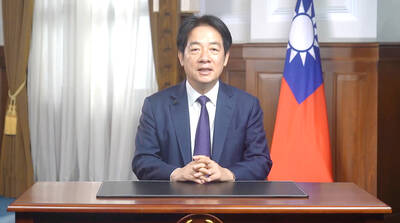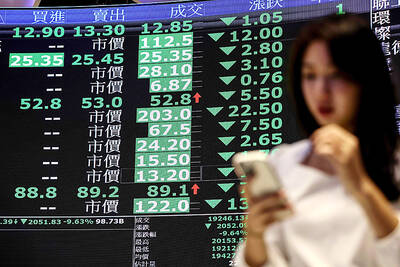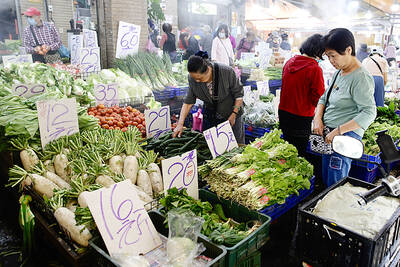President Chen Shui-bian (
Chen made the call in his opening speech to the 32th annual meeting of the World Federation of Taiwanese Associations (WFTA), which began yesterday in Brisbane, Australia. Chen delivered his address via a live video link from the Presidential Office.
WFTA, which unites overseas Taiwanese communities, has been dedicated to the promotion of Taiwanese national identity and the advancement of international support for the right of the Taiwanese people to establish an independent country since the organization was established in 1974.
In order to achieve its objective of Taiwan Independence, WFTA and other pro-independence organizations have lobbied the the Democratic Progressive Party (DPP) government to change the country's official name from the "Republic of China" (ROC) to "Taiwan."
Chen, however, told the WFTA members that, "The biggest challenge Taiwan faces today is not which name is used but that China has been doing whatever it can to deny the fact that Taiwan is an independent country and to deprive Taiwan of the rights an independent country is supposed to have."
The tactics used by China were highlighted in the Pentagon's recent report, 2005 The Military Power of the People's Republic of China, Chen said, including its military threats, efforts to interfere in Taiwanese politics and efforts to prevent his re-election.
"Simply speaking, except for its traditional military threat, China has reinforced its `united front' tactics against Taiwan, attempting to divide the Taiwanese and then annex Taiwan," he said.
What Taiwan needs to do is to consolidate its people's psychological defenses, he said.
"We need to build a consensus about the country's future development. We also need to achieve a common position on cross-strait policies," Chen said.
"As long as we can unite and keep the same pace, we won't be afraid of the Chinese `united front' tactics and we can protect the sovereignty of Taiwan," he said.
Chen reiterated his two theories of the ROC's history and called on WFTA members to embrace them.
The first theory is "Four States' theory that says the nation's first stage was the establishment of the ROC in China in 1912. The second stage was when the ROC moved to Taiwan in 1949. Lee Teng-hui's (
The nation entered the fourth stage,"the ROC is Taiwan," after the 2000 presidential election and the first transfer of power.
Chen outlined his second theory, the "Three Stages" theory, that states that the ROC is an independent country, its sovereignty belongs to the 23 million Taiwanese and that any change of Taiwan's future can only be decided by its people.
The president said that the "Four Stages" theory represents the history of the country and the "Three Stages" theory stresses the country's future.
He said the two theories should not be treated separately but as a whole.
"In order to unite Taiwan and to build the common consciousness of being a new country, I hope the `Four Stages' theory can be understood and accepted," Chen said.

ACTION PLAN: Taiwan would expand procurement from the US and encourage more companies to invest in the US to deepen bilateral cooperation, Lai said The government would not impose reciprocal tariffs in retaliation against US levies, President William Lai (賴清德) said yesterday, as he announced five strategies to address the issue, including pledging to increase Taiwanese companies’ investments in the US. Lai has in the past few days met with administrative and national security officials, as well as representatives from various industries, to explore countermeasures after US President Donald Trump on Wednesday last week announced a 32 percent duty on Taiwanese imports. In a video released yesterday evening, Lai said that Taiwan would not retaliate against the US with higher tariffs and Taiwanese companies’ commitments to

Intelligence agents have recorded 510,000 instances of “controversial information” being spread online by the Chinese Communist Party (CCP) so far this year, the National Security Bureau (NSB) said in a report yesterday, as it warned of artificial intelligence (AI) being employed to generate destabilizing misinformation. The bureau submitted a written report to the Legislative Yuan in preparation for National Security Bureau Director-General Tsai Ming-yen’s (蔡明彥) appearance before the Foreign Affairs and National Defense Committee today. The CCP has been using cognitive warfare to divide Taiwanese society by commenting on controversial issues such as Taiwan Semiconductor Manufacturing Co’s (TSMC, 台積電) investments in the

HELPING HAND: The steering committee of the National Stabilization Fund is expected to hold a meeting to discuss how and when to utilize the fund to help buffer the sell-off The TAIEX plunged 2,065.87 points, or 9.7 percent, to close at 19,232.35 yesterday, the highest single-day percentage loss on record, as investors braced for US President Donald Trump’s tariffs after an extended holiday weekend. Amid the pessimistic atmosphere, 945 listed companies led by large-cap stocks — including Taiwan Semiconductor Manufacturing Co (TSMC, 台積電), Hon Hai Precision Industry Co (鴻海精密) and Largan Precision Co (大立光) — fell by the daily maximum of 10 percent at the close, Taiwan Stock Exchange data showed. The number of listed companies ending limit-down set a new record, the exchange said. The TAIEX plunged by daily maxiumu in just

‘COMPREHENSIVE PLAN’: Lin Chia-lung said that the government was ready to talk about a variety of issues, including investment in and purchases from the US The National Stabilization Fund (NSF) yesterday announced that it would step in to staunch stock market losses for the ninth time in the nation’s history. An NSF board meeting, originally scheduled for Monday next week, was moved to yesterday after stocks plummeted in the wake of US President Donald Trump’s announcement of 32 percent tariffs on Taiwan on Wednesday last week. Board members voted to support the stock market with the NT$500 billion (US$15.15 billion) fund, with injections of funds to begin as soon as today. The NSF in 2000 injected NT$120 billion to stabilize stocks, the most ever. The lowest amount it